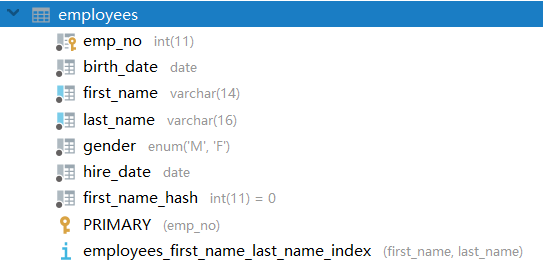Order By语句优化最好的做法是: 利用索引避免排序
哪些情况下Order by字句能用索引
MySQL排序原理
Order by调优原则与技巧
Order by调优实战
1、哪些情况下Order by字句能用索引
下图是B+Tree

利用索引本身的有序性,让MySQL跳过排序过程。
测试数据准备,如下图所示, employee有个索引index(first_name, last_name)

实例1
执行: explain select * from employees order by first_name, last_name;
返回:

type为All,全表扫描
Extra: using filesort 说明不能使用索引避免排序。
执行: explain select * from employees order by first_name, last_name limit 10;
返回:

type为index,说明加了limit ,能够使用索引。
Extra:为空, 说明能使用索引避免排序。
总结:为什么select * from employees order by first_name, last_name; 没有使用索引,因为MySQL优化器发现全表扫描开销更低时, 会直接用全表扫描。
实例2
执行: explain select * from employees where first_name = 'Bader' order by last_name;
返回:

type为ref 使用了索引
extra为Using index condition: 说明可以避免排序
执行: explain select * from employees where first_name < 'Bader' order by first_name;
返回:

type为range , 说明查询时使用了索引,并且是一个范围查询。
extra为Using index condition: 表示先按条件过滤索引,可以避免排序
执行: explain select * from employees where first_name = 'Bader' and last_name > 'Peng' order by last_name;
返回:

type为range , 说明查询时使用了索引,并且是一个范围查询。
extra为Using index condition: 表示先按条件过滤索引,可以避免排序
执行: explain select * from employees order by first_name, emp_no;
返回:

type为All,全表扫描
执行: explain select * from employees order by first_name, emp_no limit 10;
返回:

type为All,全表扫描。
总结: 无法利用索引避免排序 【排序字段存在于多个索引中】
first_name 存在于索引 index (first_name, last_name)
emp_no 存在于主键(索引)
执行:explain select * from employees order by first_name desc, last_name asc limit 10;
返回:

无法使用索引避免排序 [升降序不一致]
无法使用索引避免排序【使用key_part1(first_name)范围查询,使用key_part2(last_name)排序】
执行: explain select * from employees where first_name < 'Bader' order by last_name;
返回:

type为range说明where条件能使用索引
Extra为Using index condition; Using filesort 说明无法使用索引避免排序
2、MySQL排序模式
排序模式1 rowid排序(常规排序)
1) 从表中获取满足where条件的记录
2) 对于每条记录,将记录的主键及排序键(id, order_columne)取出放入sort buffer(由sort_buffer_size控制, sort_buffer_size专门做排序的缓存)
3)如果sort buffer 能够存放所有满足条件的(id, order_columne),则进行排序; 否则sort buffer满后,排序并写到临时文件
排序算法: 快速排序算法。
作者:Work Hard Work Smart
出处:http://www.cnblogs.com/linlf03/
欢迎任何形式的转载,未经作者同意,请保留此段声明!




 浙公网安备 33010602011771号
浙公网安备 33010602011771号